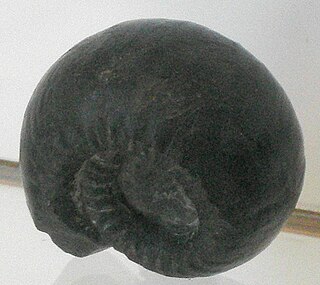Related Research Articles
Albanites is a genus of extinct cephalopods belonging to the ammonoid order Ceratitida that lived during the Early Triassic.
Frechites is an early Triassic ammonite, a kind of cephalopod with an external shell, included in the ceratitid family Beyrichitidae.
Dobrogeites is a genus of ammonoids from the order Ceratitida, included in the family Megaphyllitidae that produced evolute compressed planispiral shells with rounded venters, inner whorls ornamented as in Tirolites, outer whorls smooth, suture with multiple smooth lobes; Initially found in Anisian sediments in Romania.
Beyrichoceras is a genus belonging to the Goniatitid family, Muensteroceratidae, a group of ammonoids, extinct shelled cephalopods related to belemnites and recent coleoids and more distantly to the nautiloids
Ussuria is a genus of Lower Triassic ammonites with a smooth, involute discoidal shell with submonophyllic sutures, belonging to the ceratitid family Ussuriidae.

Ceratitida is an order that contains almost all ammonoid cephalopod genera from the Triassic as well as ancestral forms from the Upper Permian, the exception being the phylloceratids which gave rise to the great diversity of post Triassic ammonites.

Gastrioceratoidea is one of seventeen superfamilies in the suborder Goniatitina, ammonoid cephalopods from the Late Paleozoic.
Thalassoceratidae a family of late Paleozoic ammonites included in the goniatitid superfamily Thalassoceratoidea along with the Bisatoceratidae. Some eight genera are included, although the specific number and exactly which depends on the particular classification.

Ammonitina comprises a diverse suborder of ammonite cephalopods that lived during the Jurassic and Cretaceous periods of the Mesozoic Era. They are excellent index fossils, and it is often possible to link the rock layer in which they are found to specific geological time periods.
Michiganites is a member of the ammonoid order Prolecanitida, named by Ruzhencev in 1962, which comes from the Meramacian stage of Mississippian Period.
Ussurites is an extinct ammonoid cephalopod genus belonging to the suborder Phylloceratina and is included in the family Ussuritidae. Its range is restricted to the early Middle Triassic, (Anisian)

Gymnites is a genus of ammonoid cephalopod from the Middle Triassic belonging to the ceratitid family Gymnitidae. These nektonic carnivores lived during the Triassic period, Anisian age.

Hoplitoidea, formerly Hoplitaceae, is a superfamily of mostly Upper Cretaceous ammonites comprising families united by a similar suture pattern with multiple similar elements that tend to decrease in size going toward the umbilicus, at the inner edge of any whorl, and which are typically in a straight line. Sutural elements are commonly ammonitic, but in some saddles and in others both saddles and lobes are smooth and undivided. Shells are variable in form, both ribbed, evolute forms and smooth, involute forms are included.
Biloclymenia is a genus in the ammonoid order Clymeniida which is characterized by a dorsal retrosiphonitic siphuncle with long adapically pointing septal necks.

Ophiceras is a genus of smooth, evolute ceratitid ammonites from the Early Triassic, with a rounded venter. Fossils of the genus have been found in Armenia, Azerbaijan, China, Greenland, and India.
Meekoceras is a genus of ceratitid ammonites with a discoidal shell that lived during the Early Triassic Epoch.
Clypeoceras is a genus of ammonites with an involute discoidal shell from the Lower Triassic.
Eophyllites is a genus of ammonoid cephalopods from the Lower Triassic and a predecessor of genera like Monophyllites and Ussurites.
Palaeophyllites is a genus of ammonoids from the Lower Triassic and a contemporary of the related ussuritid Eophyllites.
Flickiidae is a family of dwarf ammonites with little ornament and very simples sutures known from small pyritic specimens found in middle Cretaceous deposits. Inclusion in the Acanthoceratoidea is tentative.
References
- Arkell, et al., 1957. Mesozoic Ammonoidea, Treatise in Invertebrate Paleontology, Part L (L157). Geological Society of America.
- Dieneria entry in the Paleobiology Database